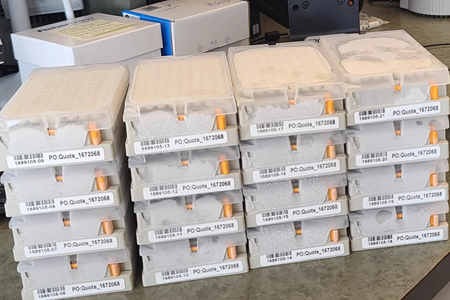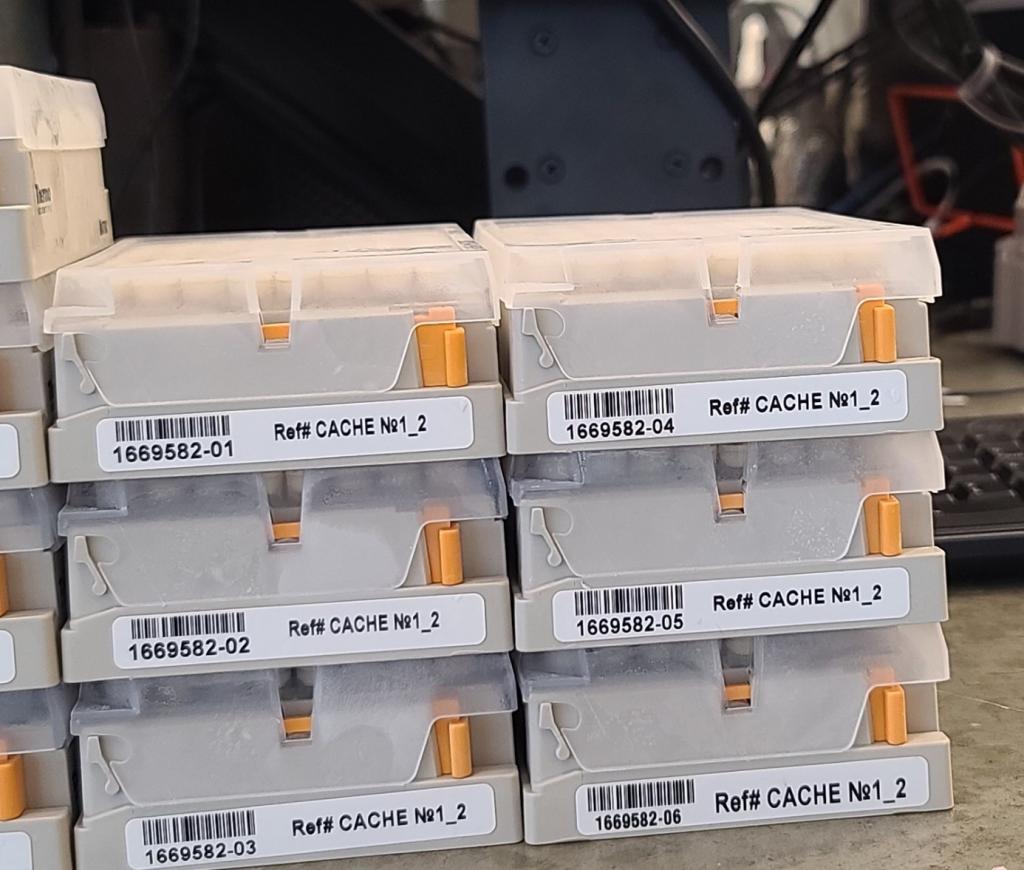CACHE News
10th November 2025
Experimental Results from a total of 1338 compounds predicted to occupy one or multiple sub cavities of the histone binding groove of the SETB1 triple Tudor domain were sent back to the 24 participants, with 29 Parent Compounds advancing to Round2.
8th October 2025
Preliminary results for CACHE#5 are now available. Experimental data for a total of 1455 compounds was shared with 24 participants. A full dose response was observed for 26 compounds while another 18 compounds had a partial allosteric modulator (PAM) profile. These 44 compounds are advanced to Round2.
8th August 2025
Applications to participate in CACHE7 are now open! Use your method to identify a minimum of 100 orthosteric inhibitors that are selective for PGK2 over its close homologue PGK1. Applications close October 10th, 2025.
16th June 2025
All CACHE4 data is now available. Out of 23 participating teams, 1 team was successful in generating a clearly novel chemical hit with strong experimental validation. A different molecule predicted by another team also showed convincing experimental confirmation but was chemically related to CBLB ligands previous disclosed in the patent literature.
17th December 2024
1455 compounds predicted by 23 CACHE#5 participants to bind to MCHR1, a GPCR, were shipped from Enamine in Kyiv and have arrived at Bryan Roth's lab at UNC for experimental screening.
5th September 2024
1553 compounds were selected by 23 participants for CACHE5 Round1.
3rd July 2024
Computational methods used to predict MCHR1 agonist have now been posted for CACHE # 5
26th August 2024
There was an order of 229 follow-up compounds selected by 8 participants for CACHE4 Round 2.
9th May 2024
9 participants to CACHE3 had their predicted SARS-CoV2 NSP3 hit(s) experimentally confirmed in Round1. They each selected up to 50 analogs to generate SAR. We just received 296 compounds from Enamine. CACHE3 Round2 experimental screening is about to begin.
8th May 2024
Applications to participate in CACHE6 are now open! Use your method to predict up to 100 compounds targeting the triple Tudor domain of SETDB1, an immuno-oncology target. Apply by June 15th!
9th April 2024
The preliminary results on the experimental testing of 1688 compounds predicted by 23 CACHE Challenge #4 participants to find hits for the TKB domain of CBLB have been posted. 10 compounds from 9 participants selectively bind to CBLB with a KD < 150 µM and are advancing to Round 2: hit expansion.
12th March 2024
Over 100 highly engaged attendees joined the inaugural CACHE symposium on March 6th and 7th in Toronto, with a lot of questions for speakers and a roaring Poster session. The take-home message is that the field is in an exploratory mode, where diverse methods are combined in a variety of screening strategies. Among the top seven performing workflows, three relied on a fragment-based strategy, four included a generative design step and six included deep learning.
19th February 2024
In-depth perspective on the first CACHE challenge in Nature Reviews Drug Discovery.
13th February 2024
Congrats to the UBC/CMU team on their successful participation in CACHE #1: https://www.cmu.edu/mcs/news-events/2024/0212_team-wins-cache-drug-discovery-challenge.html.
9th February 2024
Results of CACHE #1 were covered in C&EN and Fierce Biotech.
24th January 2024
The preliminary results on the experimental testing of 1739 compounds predicted by 23 CACHE Challenge #3 participants to bind the Macro domain of SARS-CoV-2 NSP3 have been posted. Twenty-eight compounds selected by 9 participants were confirmed and advanced to the next round: hit-expansion.
19th January 2024
16 CACHE #2 participants advanced to Round 2: hit expansion. The biophysics team at the Structural Genomics Consortium, University of Toronto, just received their 617 selected analogs. Screening is about to begin against the SARS-CoV-2 helicase NSP13!
16th January 2024
All CACHE #1 data are now available. Seven out of 1955 compounds predicted by leading experts were convincingly confirmed experimentally. This is today's state-of-the-art for binding sites with no prior ligand. Six of the seven top performing methods explored modern machine learning techniques. The confirmed hits are good chemical starting points to investigate a novel therapeutic hypothesis against Parkinson's disease.
All seven top-performing groups will present their methods, results and impressions at the inaugural CACHE symposium on March 6-7th in Toronto.
23rd September 2023:
Experimental data on 800 hit expansion compounds for CACHE Challenge #1, Round 2 have been shared with participants. The CACHE hit evaluation committee is currently reviewing the aggregated experimental data on all compounds and results will be made public on 20th December 2023.
15th September 2023:
In total 1921 compounds selected by 23 CACHE Challenge #4 participants have been ordered from Enamine. These novel chemical scaffolds must bind to the closed conformation of the CBLB TKB domain with a KD below 30 micromolar. Experimental validation will follow.
29th August 2023:
Computational methods used to predict ligands for the TKB domain of CBLB in CACHE Challenge #4 have been posted.
16th August 2023:
All 1739 compounds shipped by Enamine in Kyiv and predicted by 25 participants to CACHE Challenge #3 to bind SARS-CoV-2 NSP3 Mac1 are now received in Toronto. Screening by HTRF and DSF (at the SGC Toronto) and by crystallography at UCSF's Fraser lab is about to begin.

9th August 2023:
The preliminary results from the experimental validation of 1957 compounds for CACHE Challenge #2, Round 1 have been posted. Forty-six compounds selected by 18 participants are advancing to the hit-expansion phase (Round 2).
1st August 2023:
23 participants to CACHE Challenge #4 have submitted their predicted ligands targeting the TKB domain of CBLB, an E3 ubiquitin-protein ligase. Compounds will be ordered from Enamine and validated experimentally.
9th July 2023:
Preliminary experimental data on the primary screen by SPR was sent to CACHE Challenge #2 participants.
19th June 2023:
714 chemical follow-ups of compounds of interest selected by 18 participants to CACHE Challenge #1 arrived last week from Ukraine. Experimental screening against LRRK2 to begin this week. All data expected to be released in December 2023.

2nd June 2023:
Based on the double-blind peer-review, 25 groups from biotech, pharma and academia are invited to participate in CACHE Challenge #4 and will now predict hits to the TKB domain of CBLB, an E3 ubiquitin-protein ligase and immuno-oncology target with an inhibitor in the clinic.
1st May 2023:
Computational methods used to predict ligands for the MACRO domain of SARS CoV-2 Nsp3 in CACHE Challenge #3 have been posted.
3rd April 2023:
800 hit-expansion compounds selected by 18 CACHE Challenge #1 participants to interrogate the SAR of their primary LRRK2 hits were ordered from Enamine.
24th March 2023:
The preliminary results from the experimental validation of compounds for CACHE Challenge #1 have been posted.
CACHE Challenge #3 participants submitted their predicted hits for SARS CoV-2 Nsp3.
10th March 2023:
1951 compounds predicted by 25 participants from biotech, pharma and academia shipped by Enamine in Kyiv just arrived in Toronto. Experimental validation for binding to SARS-CoV-2 NSP13 is about to begin.
9th March 2023:
Call for applications is open for CACHE Challenge #4 finding ligands targeting the TKB domain of CBLB, an E3 ubiquitin-protein ligase with hundreds of compounds reported in the patent literature from multiple organizations, all chemically related. CACHE participants are asked to predict compounds with new scaffolds.
26th January 2023:
6 biotechs and 19 academics topped the double-blind peer review to join CACHE Challenge #3. They will predict novel chemical scaffolds targeting the MACRO domain of SARS-CoV-2 NSP3.
17th December 2022:
Experimental data on 1955 compounds was sent back to participants to CACHE Challenge #1. The data included binding to the WDR domain of LRRK2 assessed by SPR, BLI, ITC, 19F NMR. The solubility and absence of aggregation of the compounds was measured by DLS. 73 compounds selected by 18 participants were nominated to advance to the 2nd stage of the challenge: hit expansion. Until now, no ligand was known for the WDR domain of LRRK2. All data and compound structures will be publicly released here at the end of the challenge, around December 2023.
2nd November 2022:
Call for applications is open for CACHE Challenge #3 finding ligands targeting the macrodomain of SARS-CoV-2 NSP3, a target with dozens of fragments and inhibitors in the PDB, open to both receptor-based and ligand-based approaches.
1st November 2022:
Experimental data on the primary screen by SPR of 1955 compounds targeting the WDR domain of LRRK2 was sent back to CACHE Challenge #1 participants. Over 400 compounds were cherrypicked for dose response and > 120 compounds selected for validation with orthogonal binding assays, which we hope will be completed by December 1st.
23rd September 2022:
25 groups from academica, biotechs and pharma are participating in CACHE Challenge #2. The participants were selected by a double-blind peer-review process out of 41 candidates and will predict hits for the SARS-CoV-2 helicase, NSP13.
22nd June 2022:
Call for applications is open for CACHE Challenge #2, focused on the RNA-binding site of the SARS-CoV-2 helicase, NSP13. This is the most conserved drug binding site across all coronavirus proteins, and a promising target for a universal coronavirus drug. Fragment-bound structures are in the PDB.
13th May 2022:
The description of the computational methods used by the 23 participants in CACHE Challenge #1 are available on our website, revealing a great diversity of approaches (AI, physics-based, docking, pharmacophore, fragments, generative models, …).
9th May 2022:
23 teams participating in CACHE Challenge #1 have submitted their predicted hits: a total of ~2000 compounds that CACHE will purchase and test experimentally. All data will be publicly released.
7th March 2022:
25 teams from 7 biotechs, 1 pharma and 17 non-profit organizations are selected to participate in CACHE Challenge #1 composed of 3 steps:
1- Computationally select up to 100 compounds that CACHE will purchase and experimentally test for their ability to bind the WDR domain of LRRK2
2- Computationally screen the ensemble of compounds selected by all participants and predict which are active
3- Computationally select up to 50 analogs of your experimentally validated hits. CACHE will purchase and test them experimentally
24th February 2022
Background and updates on CACHE will be provided by multiple speakers at EUbOPEN, Target 2035 Webinar, 24th Feb. 2022
15th February 2022:
The CACHE white paper endorsed by co-authors from 8 pharmas and over 15 universities, biotechs and global non-profit organizations is published in Nature Reviews Chemistry
1st February 2022:
Double-blind peer review of applications for CACHE Challenge #1 is initiated. Each candidate reviews 5 applications. An independent committee uses the resulting grades to select the top 25.
1st December 2021:
Call for applications is open for the first CACHE challenge, focused on the WDR domain of LRRK2, the most commonly mutated gene in familiar Parkinson’s Disease. Apo crystal structure is in the PDB. No ligand reported so far.